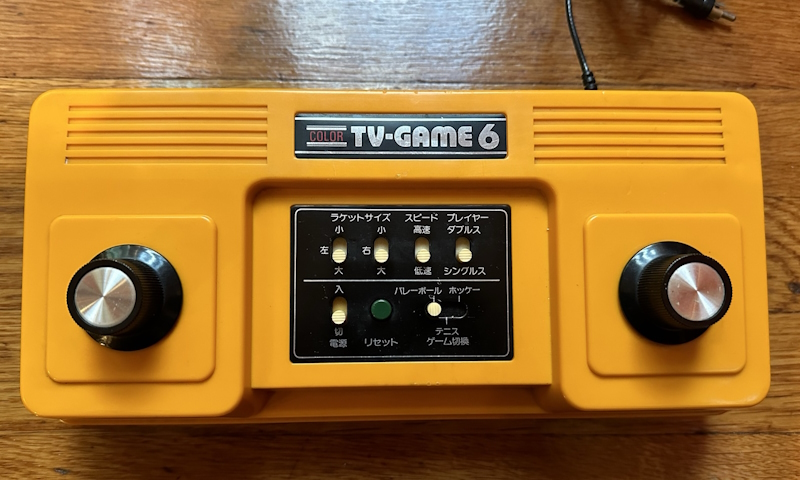Breakout Battle: Epoch vs Nintendo
In 2024, it’s easy to look back at home video games in 1979 and think of it as a time of game consoles; the Channel F and the Atari 2600 (VCS) battling it out, and the RCA Studio II was already dead. But a lot of home gaming was still happening on dedicated single-game consoles– arguably, consoles didn’t really take over until Space Invaders hit the Atari 2600 in 1980. And this was even more true in Japan. Let’s take a look at what they could come up with.
Break in, then break out. Simple.
The game of the day is Breakout. Atari in 1976 put together a formula that is perfect in its simplicity. Single-player Pong without the need for AI by making it clear that it’s simply a challenge of the player’s paddle skills. Remove all the blocks on-screen. Breakout wasn’t the first single-player arcade game, or even the first single-player video game, but it was a hit. It was also a hit in Japan, where Namco distributed Atari games after their purchase of Atari Japan in 1974.
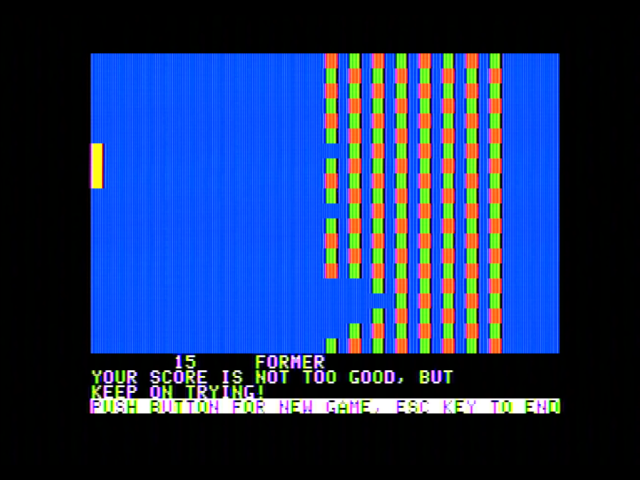
Home computer engineer Steve Wozniak famously developed a potential discrete logic PCB for Atari’s arcade game (a story in its own right, featuring another Steve), went on to create the Apple ][ with the goal of being able to do Breakout in software.
Breakout was definitely worth playing at home. The game was good, the demand was there. It’s simpler than Space Invaders. Who are our competitors?
Epoch and Nintendo
Epoch and Nintendo are both still around today, but they don’t really compete. But in 1979, they would’ve seemed pretty similar: toy companies that were branching out into electric and electronic playthings. Sure, there were some differences in the details: Nintendo did playing cards and arcade games, Epoch did dollhouses and board games; but still, not that different.
Epoch by this time had released the TV Tennis Electrotennis, a licensed console based on Magnavox Odyssey technology, the more advanced Big Sports 10 Pong clone, and TV Baseball, which used a similar µPD777-series chip as the later Battle Vader. The post-Electrotennis games were made in partnership wtith NEC, if the µPD didn’t give it away.
Nintendo had released the Color TV Game 6 and Color TV Game 15, which were not great on their release, but they fixed that. They followed it up with Color TV Game Racing 112, which was a big system with a steering wheel to play driving games that imitated Taito’s popular Speed Race (itself inspired by the electromechanical Speedway). These systems were made in partnership with Mitsubishi.
The Game Scholar notes that by this time, there was already a bit of competition going on between Epoch and Nintendo; the releases of TV Baseball and Color TV Game Racing 112 coincided and led to a price war between the two toy companies.
Epoch initially priced TV Baseball at ¥18,500 ($78) to compete against Nintendo’s Color TV Game Racing 112 which had been released two months earlier at the same price. However, once TV Baseball was on the market, Nintendo immediately lowered the price of its console to ¥12,500 ($65). Epoch quickly dropped TV Baseball to ¥13,400 ($56).
There’s an interesting problem with Breakout as a home game. The appeal of Breakout as an arcade game lies in its simplicity: you can explain the concept immediately, and understand the game. But that same simplicity that makes it appealing to put a quarter in an arcade could easily turn away your ¥9,800. (The price of Nintendo’s Breakout game– very aggressive!) It’s not just a question of how did they bring Breakout home; how did they diversify Breakout without losing its initial charm?
TV Block, TV Block, You’re all TV Block
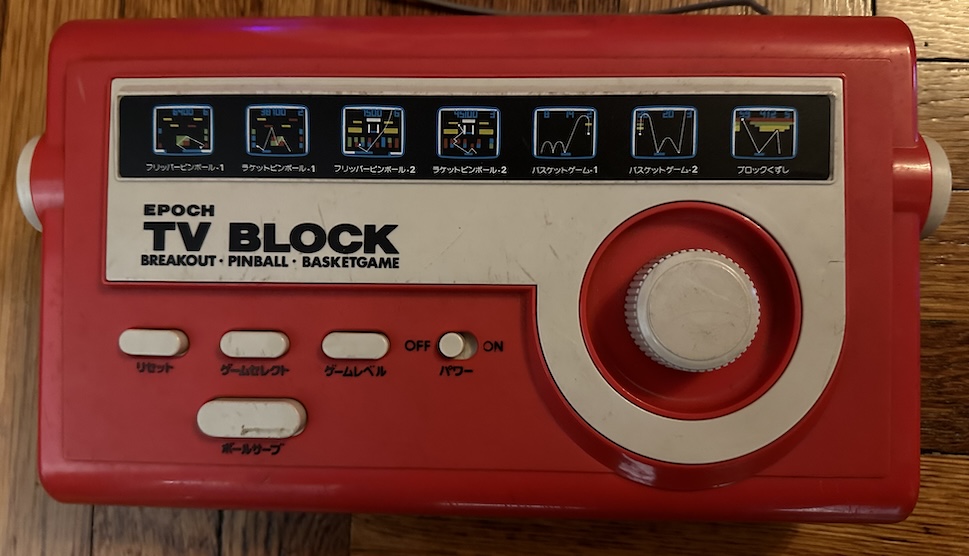
The TV Block is a good-looking console. Unfortunately, mine doesn’t work. No idea what’s going on here, I don’t even see any signal coming out of the RF modulator on the oscilloscope that I can discern.
Thankfully, that might not actually be a problem. Take a closer look at the label.
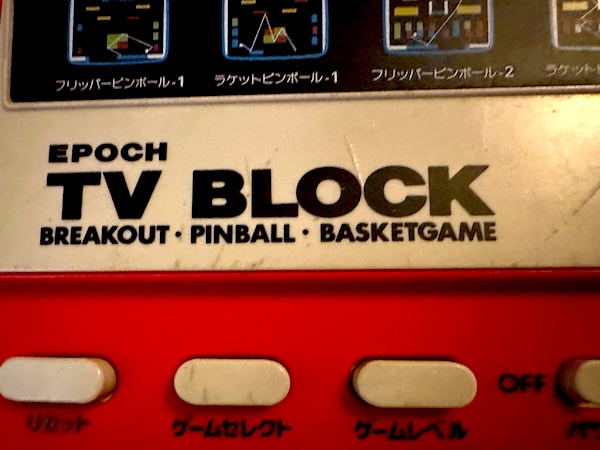
Well, I didn’t mean that label, though I do find the term “Basketgame” interesting; Basketball was definitely a known quantity in Japan in 1979. Admittedly, it wasn’t the most popular sport in the country, but both the men’s and women’s teams participated in the 1976 Olympics. Maybe Epoch just wasn’t impressed with the ability of Pong console technology to play Basketball?
![]()
Yep, it’s those icons I wanted to point out. Don’t they look… familiar?
![]()
Not quite identical, but the very same concept of icons was used on the Sears Tele-Games Pinball Breakaway, the Sears rebranding of the Atari Video Pinball C-380. And that’s not the only thing that’s the same. TV Block is, in fact, based around the very same chipset as that machine. So I can show this screenshot.
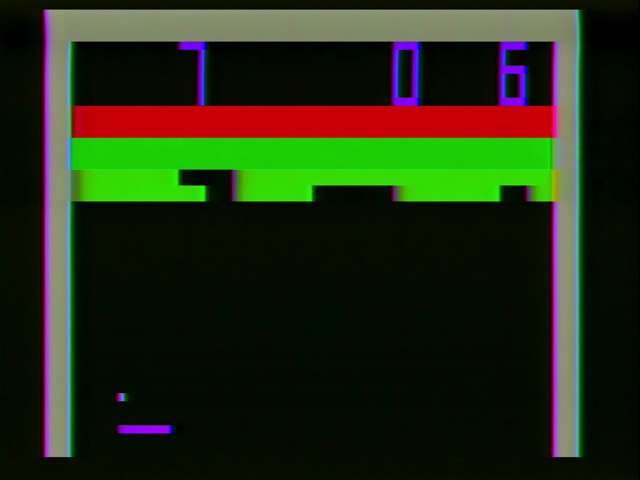
It’s Breakout. Big letters, continuous rows of bricks, and a big dial. Maybe it’s not as wood-paneled, but that wasn’t as en vogue in Japan as it was in America. (Also, Atari also put out a version of the C-380 that wasn’t wood-paneled, though it didn’t look like the TV Block)
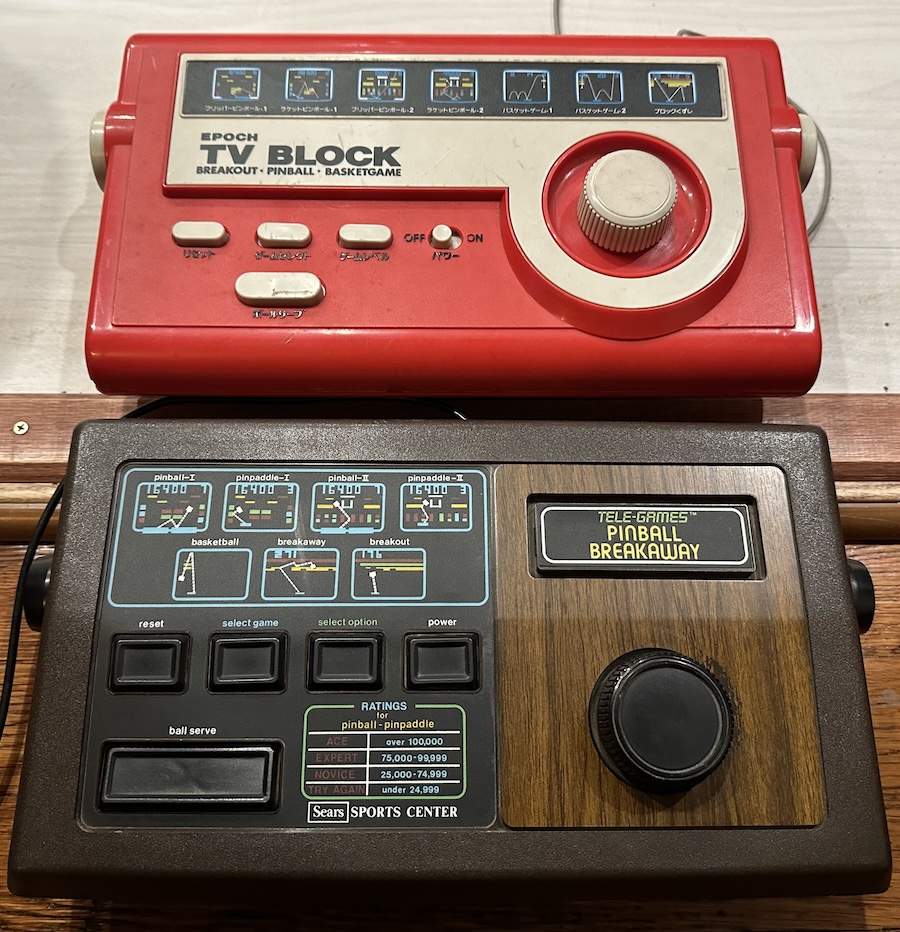
Now, the astute have probably already noticed a difference. Sure, most of the game labels are the same, but Pinball Breakaway has two Breakout games, and one basketball game. TV Block has one Breakout mode, and two basketgames. What’s the deal with that?

Well, if we look at the manual of that non-woodgrain version of the US Atari Video Pinball, we can actually see that it also has two basketball games, and only one Breakout game.

If we break open the TV Block, we find a wholly unique circuitboard; in fact, unlike all of Atari’s takes on the concept, there’s no speaker inside. The RF modulator, controlled by the UA3086PC op-amps and on-board circuitry, also mixes in audio. That actually came up in the interview with Masayuki Horie of Epoch that I mentioned in the TV Vader post.
Interviewer: Your next game was “TV Block.” This one used an Atari chip.
Horie: At this time Atari had two kinds of chips. We imported them and assembled the circuit ourselves.
Interviewer: Before TV Block, some Japanese makers were importing and selling Atari’s Video Pinball. It played sound from the console unit, though.
Horie: They probably didn’t have a voice modulator.
We also get some talk about why Epoch may have gone with Atari’s chip, rather than create something of their own using the µPD777-series they already used for TV Baseball. It seems the parabolic arcs, which are primarily only seen in the basketball and the flipper-pinball games, was very impressive.
Horie: It was really fun. When I first saw it, I was surprised. Was the ball really making a parabolic arc? I couldn’t figure out how to do that myself! I had only been able to do straight lines, so seeing that was like, “whoa!” I thought it must have been imported from overseas—there was no way a Japanese company made this. (laughs)

The chip inside the TV Block is the Atari C010755-03.

Inside the Pinball Breakaway is the C11500-03. I assume this is the later variation, because eventually, Epoch released the TV Block MB, which has the same general appearance of the TV Block, but features two Breakout games and one basketball game. Similarly, woodgrain Atari-branded Video Pinball C-380 consoles also have it, while the white plastic ones have the C010755-03.
Overall, I had positive things to say about the Sears Tele-Games Pinball Breakaway, and I still have positive things to say about it. It has a decent Breakout, though for me the pinball and pin-paddle games are really the star. Tokyo-based Epoch had a pretty solid title here. What about the boys in Kyoto?
Block Kuzushi, not to be confused with Block Karoushi
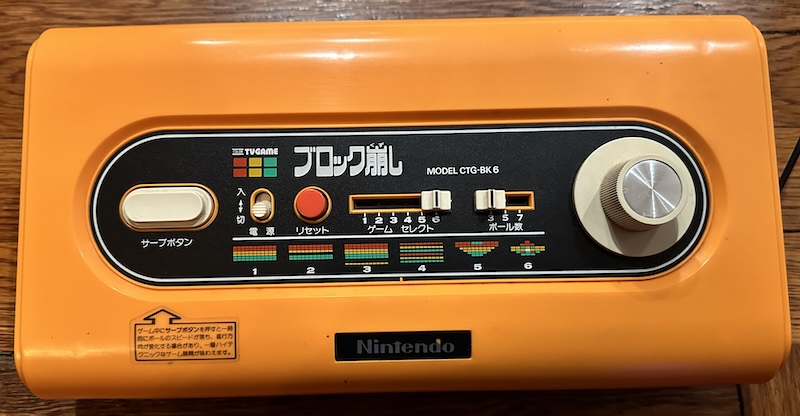
The Color TV Game Block Kuzushi (“Block Kuzushi” being the generic Japanese term for Breakout-style games) is a striking console, and gets a lot of attention for its looks. Apparently, this was the first project for the company done by a young artist named Shigeru Miyamoto, who probably did some other stuff later. The case is definitely good-looking, curvier than the prior consoles.

It’s also noted for having the Nintendo logo right up front, again unlike the prior Nintendo Color TV Game systems, which only had the kanji version of the logo on the back with the info sticker. It’s their third system and Nintendo is putting themselves out there a lot more.
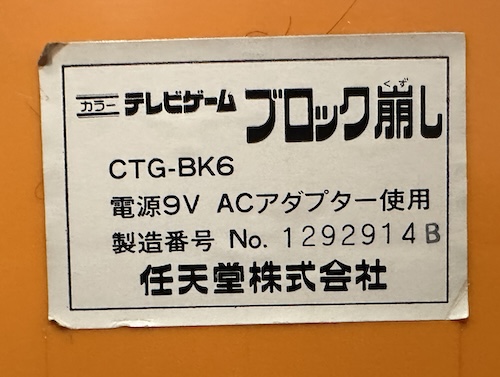
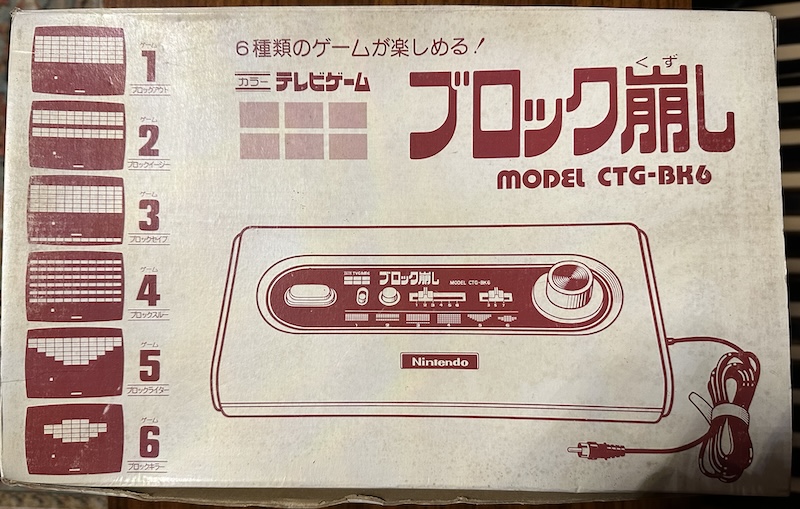
Unlike Epoch’s TV Block, I have the box for the Color TV Game Block Kuzushi. It shows off what makes the console stand out: it’s not just one Breakout game, but six of them! Unlike with Pong, there’s no variant with fifteen. Oddly, this box has the box for the AC adapter in it, but no AC adapter. But it works fine with the Famicom-style 9V DC center-negative adapter.
Game 1: Block Out
Game 1 is just as basic of a Breakout game as you can get. You bounce the ball and try to break the blocks. You know it, you love it– well, if you don’t love it, why are you this far into an article on two Breakout machines?
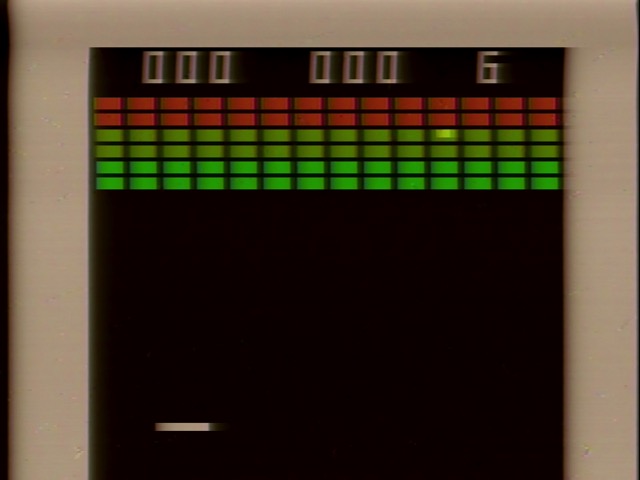
You might notice a bunch of differences from the Atari version up-front.
- A smaller font. Personally, I think this looks better, and even on a small TV or with a lot of interference it should look fine. There’s a lot of interference here, after all (more on that later)
- The blocks are individually separated. Not only is this more consistent with the Atari arcade game (despite not using the Atari chip), it’s better to play, since you know where the block boundaries are.
- Despite this, it’s really quite similar. It’s Breakout. There’s six rows. Yep.
- The ball appears to be stuck inside a brick. This is because as you serve the ball, it comes down from the top of the screen, passing through the bricks during the serve.
Game 2: Block Easy
Breakout too hard for you? Well, what if it was… easy?

You might notice the “098” on the right. That’s the score of the last game I played; when you press reset, the score moves into that position, allowing for you to remember your last score. As far as I can tell, it’s not a high score.
Block Easy makes the game easier by removing a row of bricks. This means you can have the enjoyable experience of bouncing the ball inside of a row with bricks on either side, which is fun. Plus, with one fewer row, it must be easy.
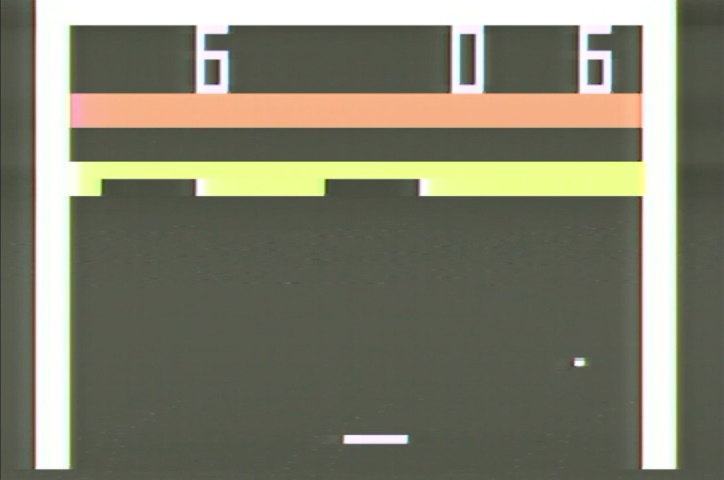
You might want to compare it to “breakaway” on the Sears Video Pinball, which is missing two rows, but is basically the same concept with the middle row missing. But remember, this game didn’t exist on Epoch’s version until they released the “TV Block MB”. And I don’t have that one.
Game 3: Block Save
Block Easy too hard for you? Understandable. But what if the room had a floor? Block Save adds a row of bricks at the bottom of the screen; you need to only clear the ones at the top, but these at the bottom will also break, giving you a single hit where it’s safe. For fun, let’s use a video rather than a still screenshot.
Game 4: Block Thru
Block Save too hard for you? Block Thru seems like an even more dramatic variation of Block Easy at first glance, with spaces between each row.
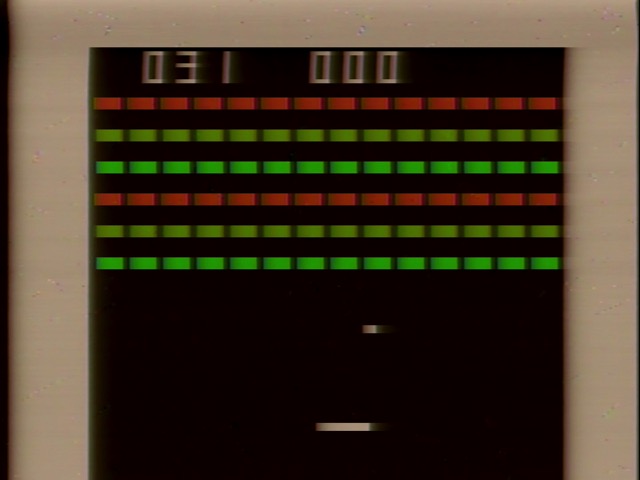
Actually, in this Breakout variant, the ball just goes right through the blocks. Some Atari versions of Breakout had a similar game variant called “Breakthru”, and that’s what this is. So the ball will leave diagonal lines as it only bounces off the side of the stage.
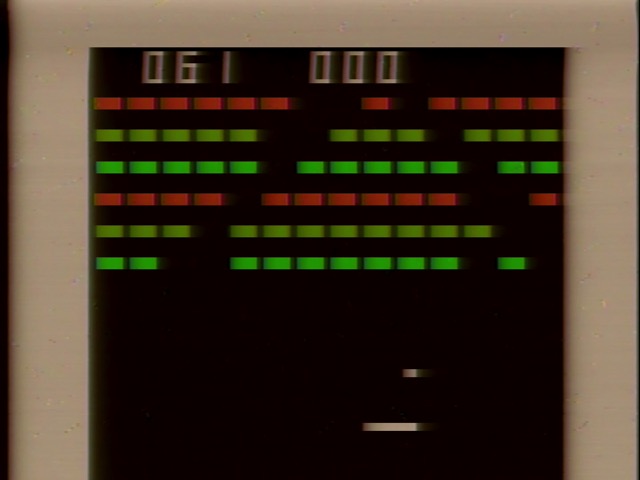
But it has more differences than just that. For one thing, the score is always counting up until you destroy the last block. (It’s also constantly playing a beep noise while doing so, which is kind of annoying) Therefore I assume the goal is to have a lower score. Also, it seems like you always have seven balls here, no matter what is selected on the console itself.

In any case, I got 777 as my final score on my try that I filmed for this blog post, which probably isn’t a good score, but at least is an interesting one.
Game 5: Block Lighter
This could be “Block Writer”, I’m just going to be consistent Before Mario’s transliteration here. Block Lighter makes more sense anyway, because of the four blocks that light on and off at the top.
The goal here is only to break the four flashing blocks; the other blocks don’t matter. Therefore you’re probably going to want to aim for the thin walls on the sides, and break up to the top, where you can bounce in and get the kill, with even a primitive victory animation. (Be warned, it’s loud)
Game 6: Block Killer
Nullsoft followed up the controversial Winamp 3 with Winamp 5, promising that it would have the best of both Winamp 2 and Winamp 3, and 2+3=5. If Nintendo had heard of that kind of math, maybe they’d have called this Game 9; it combines Game 5 and Game 4.
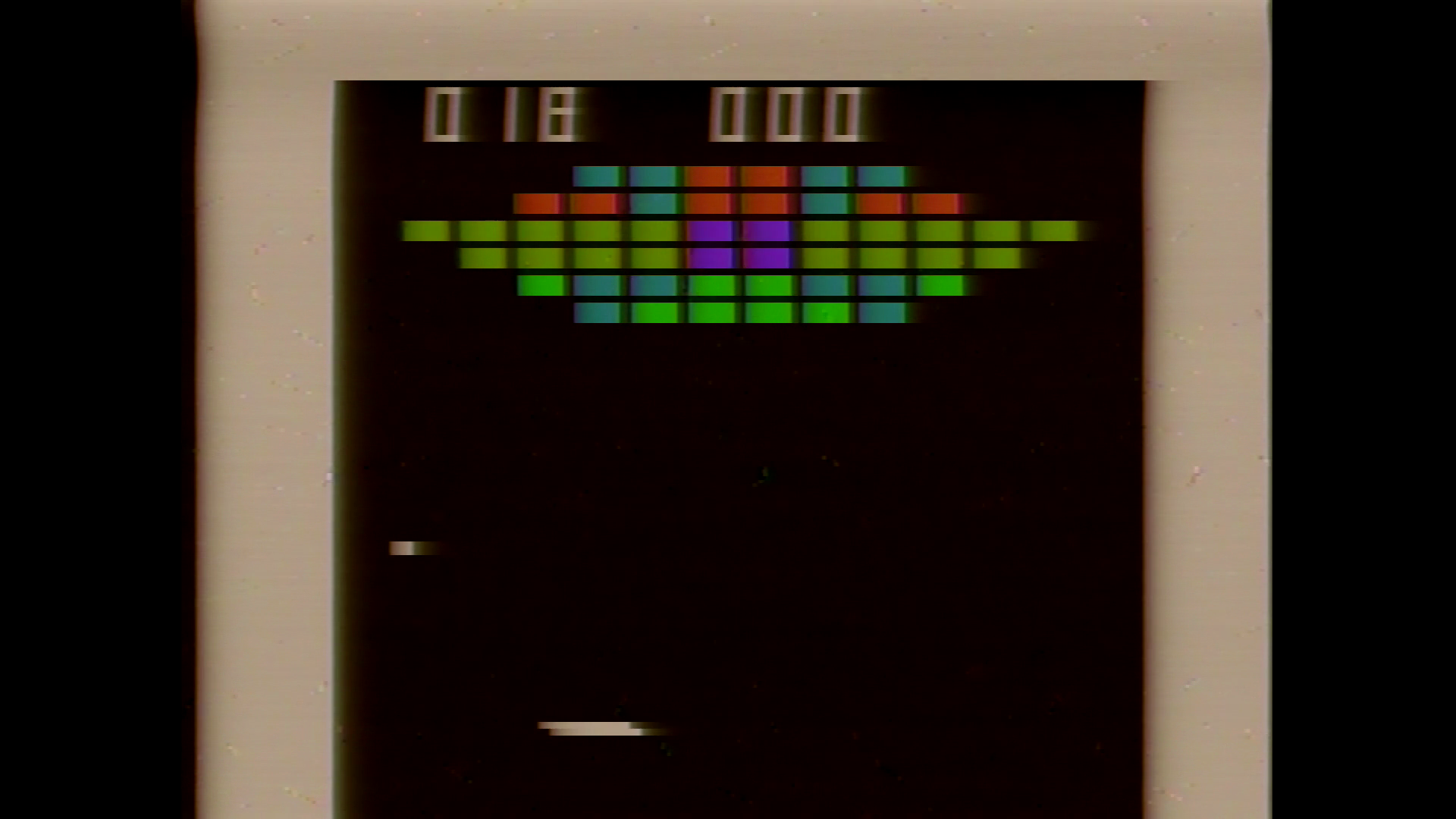
Block Killer features four flashing blocks in the center of a diamond shape. Like Game 5, your goal is to destroy these four blocks, and once they’re destroyed, the block structure falls to the bottom of the screen. But like Game 4, your score is constantly increasing, and your ball can pass through the blocks. As you can probably guess, a game of Block Killer can be completed very quickly.
And that’s the six games on Color TV Game Block Kuzushi. Just like Atari/Sears/Epoch’s game, they have additional variants, but it lacks the pinball or basketgame options, focusing only on Breakout. But I think they’ve got some pretty good variety; the higher-number games provide much faster games, which I think is one of the weaker points of Breakout; it can be pretty plodding, especially for someone raised on more modern block-breaking games like Arkanoid and Moraff’s Blast.
The power that’s inside
Color TV Game Block Kuzushi is often reported as the time that Nintendo really started to develop games themselves. And that may be true; the single-chip that powers this is still manufactured by Mitsubishi, however. I don’t know of any details; this was likely a case like the Epoch-NEC project, but we have a lot more information there thanks to the interview with Masayuki Horie at Epoch and Tetsuji Oguchi’s website.
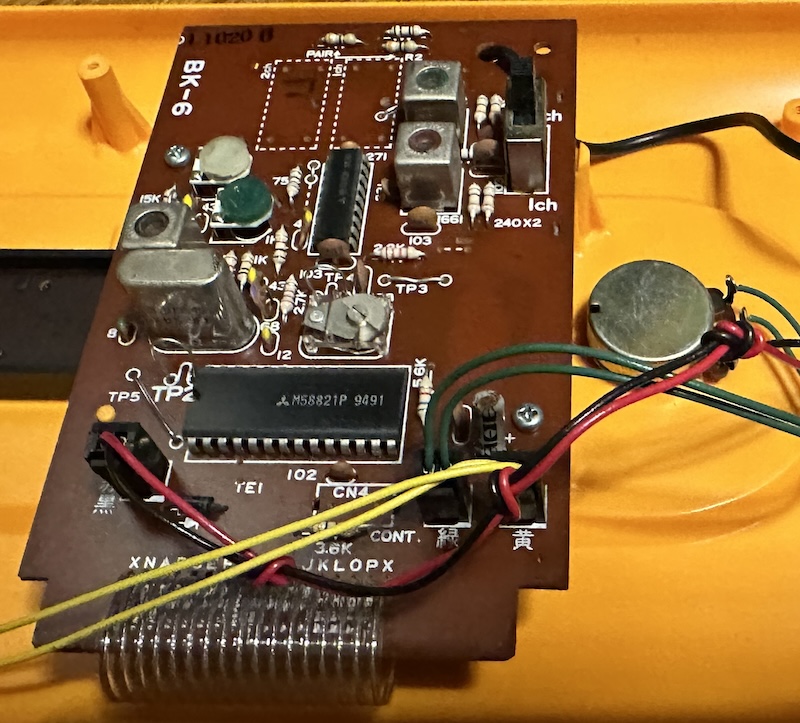
The other chip on the board is the Mitsubishi M51342P. This chip’s datasheet isn’t easily found, but user Link83 on the NFG Forums noticed that the datasheet for a different Mitsubishi chip, the M5C6847P, features a partial pinout for the M51342P modulator chip. This would be a good start for a composite mod if I want to go that route; I haven’t decided.

Oh, and Epoch should be happy, it does audio over the RF modulator as well. I wonder if the complications of FCC-required shielding made it easier to use built-in speakers in the 1970s for cheap consoles? Not sure how much avoiding modulating the audio would help.
All about those blocks
I can’t find sales figures for Epoch’s TV Block; Nintendo’s is reported as being half a million, and both seem to be pretty available today, and decently remembered. Nintendo’s is more remembered, but that might be as much a function of it being a company that went on to do, shall we say, bigger things.
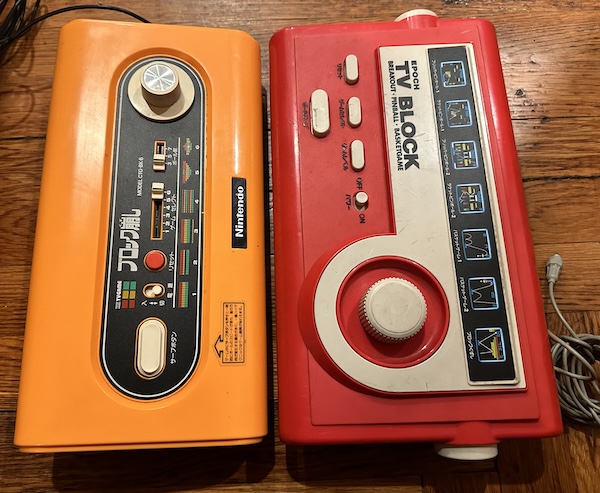
Interestingly, the Block Kuzushi was the last mass-market Nintendo single-game console in the Color TV Game series. There was the 1980 Computer TV Game, but it was a more niche product, containing circuitry (apparently) near-identical to Nintendo’s Computer Othello arcade game. I’d love to get my hands on one, but they are pretty rare, as you’d probably expect. So really it’s just this and then the 1983 Famicom.
As for TV Block, it was a detour for Epoch; the follow-on was TV Vader, which unlike TV Block, was designed in-house, and shared the basic platform with their earlier TV Baseball. So even histories of Epoch tend not to focus on it. It’s a fun system (though I recommend getting the MB if you can find it; the Breakout variants are better), but historical? Perhaps not.

